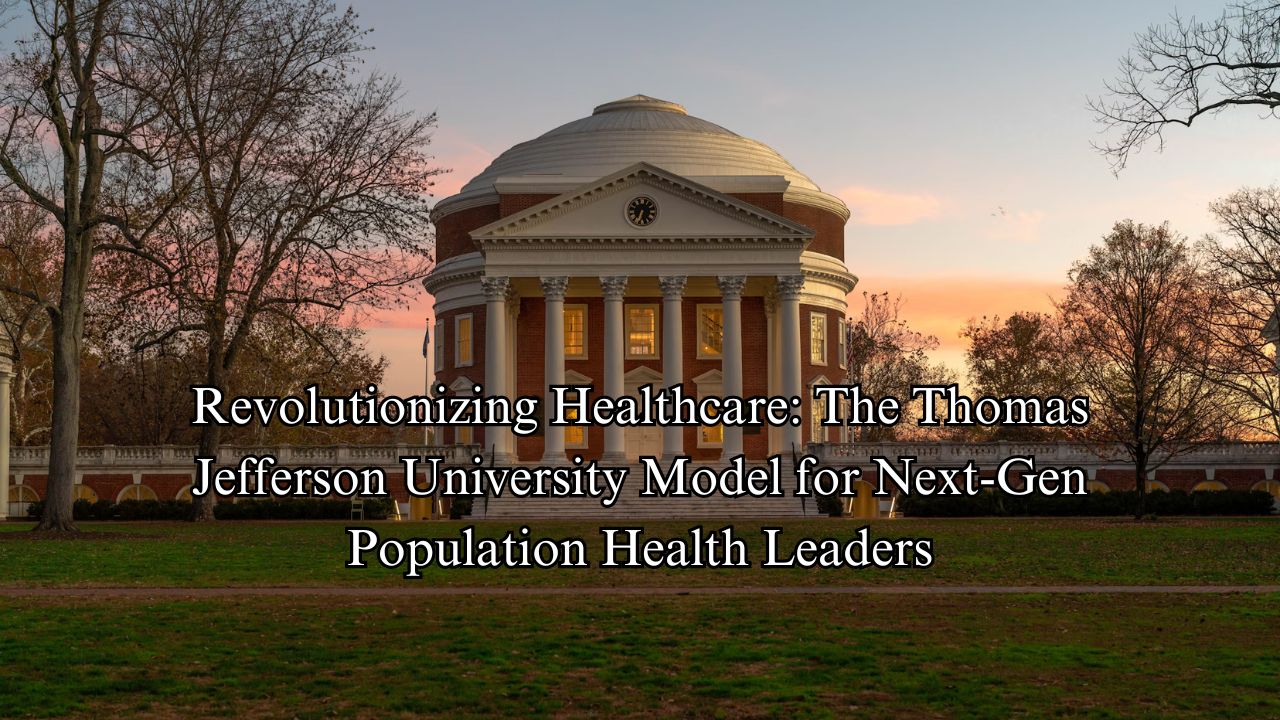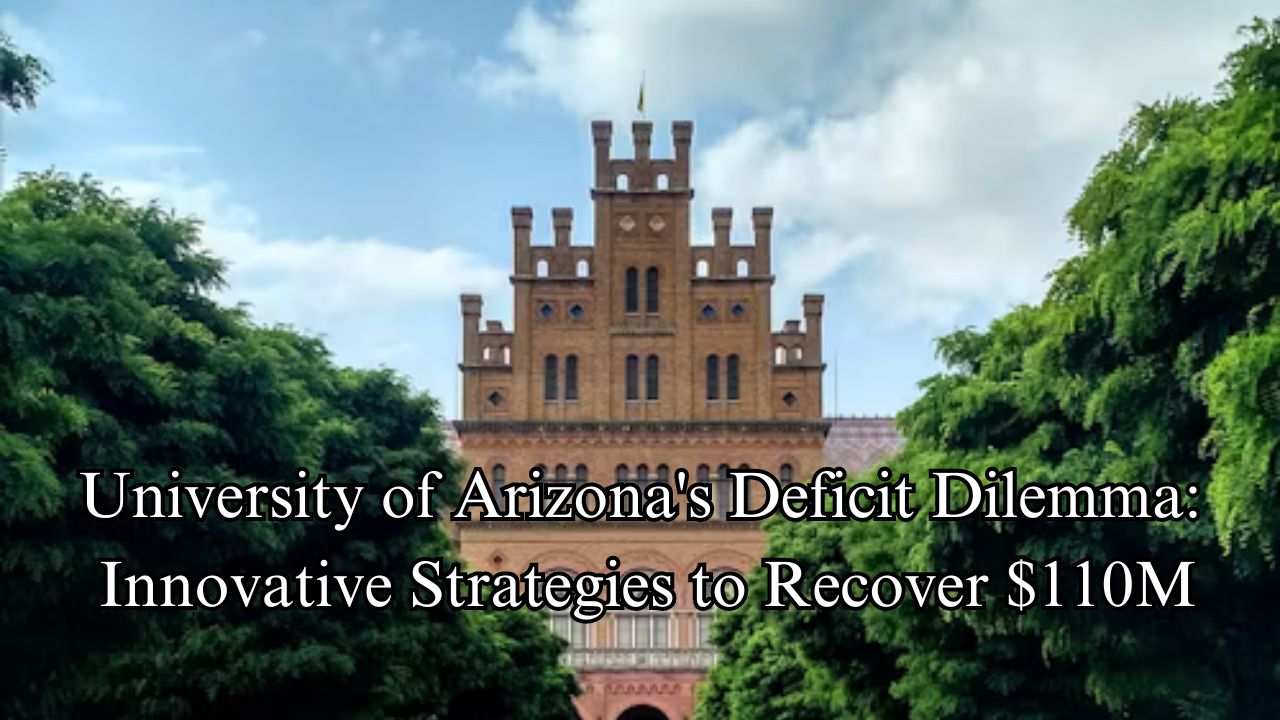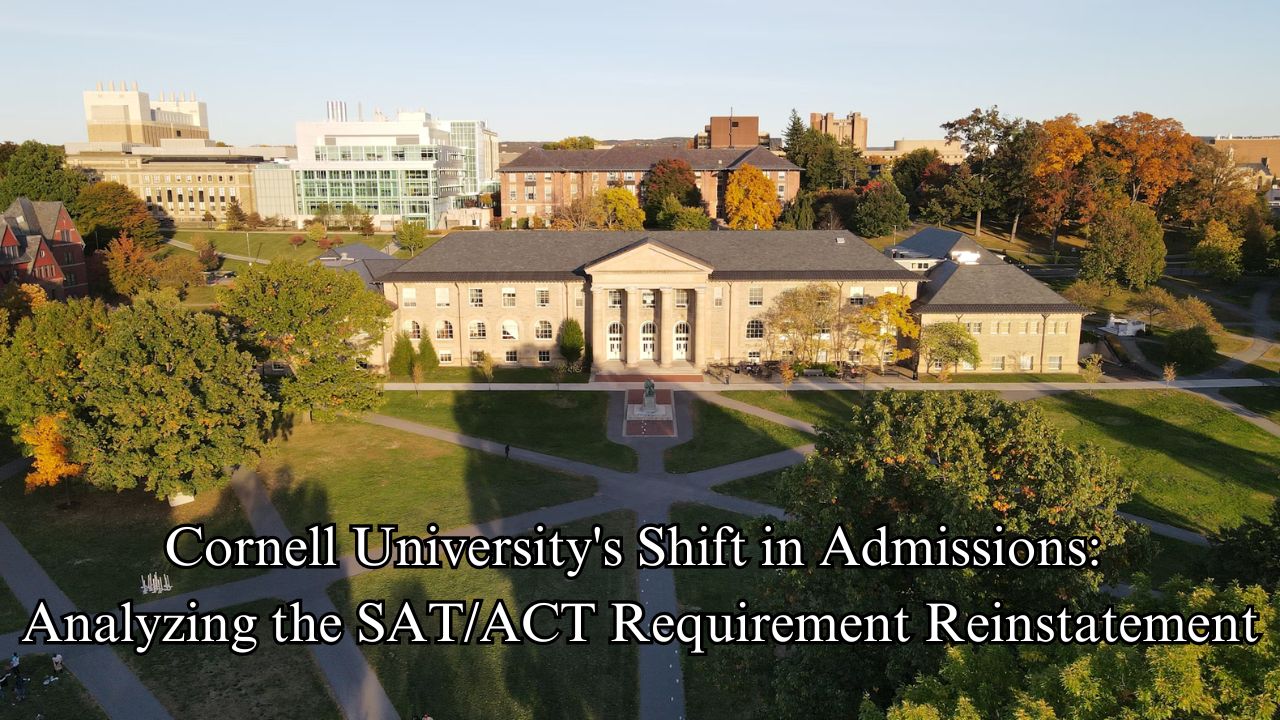Revolutionizing Healthcare: The Thomas Jefferson University Model for Next-Gen Population Health Leaders
Thomas Jefferson University stands at the forefront of advancing population health, housing the nation’s first College of Population Health 1. This pioneering institution not only holds a remarkable record of medical firsts but also actively shapes the future of healthcare through influential contributions in life expectancy, palliative care, public health, and health equity 1. Its commitment to innovation is further highlighted by its role as the editorial home to prominent peer-reviewed journals, Population Health Management and American Journal of Medical Quality 1.
The university’s model is designed to cultivate next-generation leaders skilled in addressing real-world health challenges 2. By integrating practical application with academic rigor, Thomas Jefferson University equips students to drive significant improvements across health delivery systems, emphasizing tailored health plans for vulnerable populations 2. The institution’s vast enterprise seamlessly connects students, faculty, healthcare providers, and patients, fostering a collaborative environment dedicated to achieving health equity and enhancing public health outcomes 2.
The Importance of Education Loans in Today’s Academic Landscape
Innovative Funding Models
- Income-Share Agreements (ISAs): These agreements represent a novel approach where students commit to paying a percentage of their future income for a set period in return for financing their education, aligning the interests of students with those of investors 4.
- Public-Private Partnerships: These strategic alliances between educational institutions and private sector entities help secure essential funding and resources, enhancing the educational infrastructure 4.
- Income-generating Assets: Universities are increasingly turning to income-generating assets such as real estate and partnerships with developers to diversify income streams and stabilize financial bases 4.
- Social Impact Bonds (SIBs): These bonds connect financial returns to educational achievements, with the public sector rewarding improved outcomes, which in turn shares savings with investors 4.
- Microfinance for Education: Focused on educational expenses, microfinance provides a channel for investors to impact education access directly 4.
Challenges and Solutions in Education Financing
- Over the last three decades, the escalation in college tuition has outpaced median incomes, placing a heavier debt burden on many Americans 5. The Biden-Harris Administration has responded with initiatives like the Student Debt Relief (SDR) and The SAVE Plan to mitigate this issue, aiming to enhance earnings and credit scores while reducing delinquency rates 5.
- The growth of student loan balances, which increased threefold from 2004 to 2014, exemplifies the burgeoning financial strain on students, necessitating innovative solutions like the Loans for Educational Opportunity (LEO) proposed by The Hamilton Project 67.
- The Federal Reserve Bank of Philadelphia emphasizes the significant impact of educational loans on the U.S. economy and explores alternative educational paths such as apprenticeships to make education more accessible 8.
- A survey by the National Education Association highlighted that nearly half of educators have incurred debts to finance their education, with many still grappling with significant balances, underscoring the need for more sustainable wage structures and loan repayment options 9.
These insights into the evolving landscape of education financing illustrate the critical role of innovative funding strategies and governmental support in ensuring education remains accessible and sustainable for future generations.
Overview of Thomas Jefferson University’s Population Health Program
Thomas Jefferson University’s Jefferson College of Population Health stands as a beacon of innovation and leadership in the fields of population health, public health, healthcare quality and safety, health economics, and health policy 13. The college is distinguished not only by its comprehensive educational offerings but also by its significant contributions to the field through its leadership in national peer-reviewed journals and industry-leading textbooks 1.
Key Components of the Program
- Educational Offerings: The college provides a robust selection of degrees, including master’s and doctoral programs in several specialized areas such as Health Data Science, Health Policy, and Healthcare Quality & Safety, alongside various graduate certificates 19.
- Interprofessional Education (IPE): This critical component fosters collaborative practice among health professionals, enhancing team-based skills and integrated clinical education 15.
- Social Determinants of Health: An integral part of the curriculum, focusing on the large-scale social, economic, and environmental issues that impact health outcomes 15.
- Advanced Practice Certificates (APC): These certificates allow professionals to deepen their expertise in specific areas of population health or population health education 20.
- Online Learning Flexibility: The program offers 100% online courses, accommodating professionals with busy schedules through an accelerated 7-week term format 20.
Strategic Initiatives and Innovations
- Population Health Intelligence M.S. Program: This program equips students to use tools for addressing health-related questions, combining public policy, evidence-based strategies, population data, and economic analysis 19.
- Integration with Precision Medicine: The program emphasizes the convergence of precision medicine with population health strategies to tailor pharmacopeia to individual needs, enhancing treatment effectiveness 13.
- Linking Executive Compensation to Health Outcomes: Inspired by models like Trinity Health System, the program advocates for accountability in health outcomes as a key driver for enhancing population health management 13.
The Jefferson College of Population Health not only educates future leaders but also actively engages in addressing immediate community needs through substantial endowments and health equity initiatives, thereby advancing equitable population health 1.
Financing Your Education at Thomas Jefferson University
Thomas Jefferson University provides a comprehensive array of financial aid options to support students throughout their educational journey. For the academic year 2024-25, detailed information on tuition, fees, and room & board is readily accessible on the university’s website 22. A significant majority of students, over 94%, benefit from some form of financial aid including grants, loans, work-study programs, and scholarships 22. The Financial Aid Office plays a pivotal role in guiding students through the process of identifying and applying for these financial resources 22.
Financial Aid Management by Campus
Financial aid services are tailored and managed according to campus locations, which include Center City Campus, Dixon Campus, East Falls Campus, Voorhees Campus, and Sidney Kimmel Medical College 23. This decentralized approach ensures that the specific needs of students at each campus are met efficiently.
Support for Continuing and Professional Studies Students
Students enrolled in Continuing and Professional Studies at Thomas Jefferson University also have access to financial aid in the form of grants, loans, campus employment, and scholarships, ensuring that all students have the necessary support regardless of their program or stage of education 23.
Comprehensive Financial Literacy and Debt Management
The Financial Aid Office not only assists with securing funding but also offers individualized support in financial literacy and educational debt management. This is crucial for helping students manage their finances wisely during and after their educational programs 24. The office is conveniently located at both the Center City and East Falls campuses to serve students effectively 24.
Application Process for Financial Aid
Prospective and current students are encouraged to apply for financial aid through the Free Application for Federal Student Aid (FAFSA), using the school code 013549 for all colleges within the university, except for Sidney Kimmel Medical College which uses the code 010021 24. This process is vital for accessing a wide range of financial aid options tailored to the needs of students.
Diverse Financing Options
Thomas Jefferson University offers a variety of financing options including scholarships, grants, loans, and work-study programs, designed to accommodate the financial needs of all students 25. Additionally, transfer students and members of Phi Theta Kappa are considered for specific scholarships, enhancing the financial support available to them 25. Students are also encouraged to explore outside scholarship opportunities to further supplement their funding options 25.
The Financial Aid Office is dedicated to assisting students in securing federal, state, institutional, and private funding, which are essential for covering the costs of their education 24. This comprehensive support system ensures that students can focus on their studies with fewer financial worries.
Success Stories: Graduates of the Program
Scott Goldfarb’s Journey in Health Economics
Scott Goldfarb, who graduated with a degree in Applied Health Economics & Outcomes Research in 2022, previously engaged in extensive training in pharmacy school and residency. His specialized training in managing population health led him to a role in the global health outcomes group at a pharmaceutical company. Scott’s decision to refresh his formal training in outcomes research at Thomas Jefferson University propelled him into a new career phase at BeiGene. In his unique market access role, he develops strategies that significantly benefit oncology patients and enhance public health outcomes [33].
Janice Nissen: From Nursing to Population Health Leadership
Janice Nissen earned her degree in Population Health in 2019 after a diverse career spanning nursing, sales leadership, operations, marketing, and patient engagement in life science companies. Her aspiration to deepen her understanding of global and population health motivated her enrollment. Today, Janice applies her broadened perspective effectively in her role at Merck. She also contributes as a JCPH Alumni Board member and serves as a consultant and trustee at Helene Fuld College of Nursing, demonstrating the practical application of her education [33].
Abbey Pitzer: Digital Strategy at the White House
Abbey Pitzer, an alumna of the Thomas Jefferson University Population Health Program, now plays a pivotal role in Joe Biden’s Office of Digital Strategy. Her focus is on enhancing the connection between the White House and the American public through transparent and engaging digital communications. This position underscores the versatility of the population health program in preparing graduates for impactful roles beyond traditional healthcare settings [34].
Aquiera Halsey’s Impactful Career Post-Graduation
Aquiera Halsey, another distinguished graduate of the Thomas Jefferson University College of Population Health, has her success story featured on Drexel University’s LeBow College of Business website. Her career trajectory post-graduation highlights the significant opportunities that the program opens up for its alumni [35].
David Nash: A Leading Voice in Population Health
David Nash, a graduate of Thomas Jefferson University, is now recognized as a leading voice in the field of population health. His work has garnered accolades from notable figures in the medical community, such as Steven Scheinman, MD, and Brent James, MD, further illustrating the high caliber of the university’s alumni [37].
Navigating the Loan Application Process
Step 1: Research Your Options
Before diving into the application process, it’s crucial to understand the different types of student loans available. These include direct subsidized, direct unsubsidized, PLUS, and consolidation loans 10. Each type has its specifics regarding interest rates, repayment options, and eligibility criteria. For instance, federal loans offer low fixed interest rates with no credit check or co-signer required, and repayment begins only after graduation 10. In contrast, private loans might require a credit check and a co-signer, and sometimes repayment starts while you’re still in school 10.
Step 2: Complete the FAFSA
The Free Application for Federal Student Aid (FAFSA) is your gateway to accessing federal student loans and many state-based aid programs 11. This form collects essential financial information to determine your eligibility for aid 11. It’s advisable to complete the FAFSA as early as possible since some aid is awarded on a first-come, first-served basis 12.
Step 3: Understand Your Award Letter
After submitting the FAFSA, your school’s financial aid office will send you a financial aid award letter. This letter details the types and amounts of aid you qualify for 11. Carefully review this letter to understand the terms of each type of aid and calculate the amount you’ll need to cover your educational expenses 12.
Step 4: Apply for Additional Loans if Necessary
If the financial aid from federal sources does not cover all your educational expenses, consider applying for private student loans. Research different lenders to compare interest rates and repayment terms 11. Remember, a creditworthy co-signer can improve your approval chances and help secure better interest rates 11.
Step 5: Loan Approval and Disbursement
Once your loan application is approved, the lender will notify you about the loan amount and the terms and conditions 11. The approved loan funds are typically disbursed directly to your school at the beginning of each academic term to cover tuition, fees, and other education-related expenses 11.
Step 6: Master Loan Management
Understanding loan management strategies is essential for handling your student loan debt effectively. Consider budgeting, making extra payments, and exploring options for consolidating and refinancing your loans 10. Additionally, some employers offer student loan repayment programs which can be a valuable resource 10.
By following these steps and utilizing resources like the FSA Loan Simulator and CFPB College Planner, you can navigate the loan application process with greater confidence and clarity 10.
Future of Education Financing and Population Health Leadership
Thomas Jefferson University continues to spearhead transformative initiatives in healthcare, focusing on areas like cancer research, climate solutions, and new mobility treatments, while forging strategic partnerships to enhance their impact 1. The public health sector anticipates significant shifts with an influx of entry-level workers, necessitating a pivot towards branding, modernization, and an expanded, diversified workforce 26. This evolution involves a shift towards Just-in-Time Learning, which emphasizes acquiring skills through industry-driven, asynchronous learning modules, reducing the initial period of extensive schooling 26.
Remote work preferences are reshaping governmental agencies, which must now balance equity among positions with organizational and community needs 26. Furthermore, the acceleration of data collection and sharing is crucial, as the future workforce will need to leverage this data for effective decision-making 26. Addressing public health burnout is also critical, requiring robust mental health support and nurturing workplace cultures to retain valuable staff 26.
Reimagining systems to tackle the root causes of health inequities is essential for advancing public health 26. Health leadership now more than ever focuses on identifying priorities and providing strategic direction to various actors within the health system, fostering a commitment to enhance health services 27. Effective management will be pivotal in facilitating change and ensuring the efficient mobilization and utilization of health resources 27.
Conclusion
Through the pioneering efforts of Thomas Jefferson University, particularly in its role as a leader in population health education and innovative education financing, we’ve traced a blueprint for future healthcare leaders and the sustainable financing of education. The university’s comprehensive approach, from its integrative educational models to diverse financial aid options, signposts the way forward for addressing today’s pressing health challenges and the economic barriers to education. These initiatives not only equip students with the skills needed to excel in the healthcare field but also ensure that financial constraints do not hinder their educational pursuits.
As we look to the future, the significance of Thomas Jefferson University’s contributions to healthcare education and the broader implications for the public health sector cannot be overstated. The university’s forward-thinking strategies serve as a beacon for adapting to the evolving landscape of public health and education financing. By nurturing the next generation of health leaders and innovating in financial aid, Thomas Jefferson University is laying the groundwork for a healthier, more equitable society where education is accessible to all, and population health strategies continue to evolve to meet community needs.
FAQs
What are the benefits of paying for healthcare services out-of-pocket? Paying for healthcare services out-of-pocket can lead to several advantages. Firstly, it prompts individuals to be more judicious with their healthcare spending, as they bear the direct costs. Secondly, it gives them the opportunity to compare prices and seek the best value for medical services. Lastly, it can drive healthcare providers, including doctors and hospitals, to maintain high-quality care in order to attract and retain patients.
Who currently holds the position of Chief Medical Officer at Jefferson Health? As of 2018, Dr. Yehia has been appointed the role of Chief Medical Officer at Jefferson Health.









